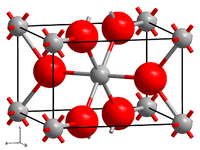Niobium (IV) oxide
| Crystal structure | ||||||||||||||||
|---|---|---|---|---|---|---|---|---|---|---|---|---|---|---|---|---|

|
||||||||||||||||
| __ Nb 4+ __ O 2− | ||||||||||||||||
| General | ||||||||||||||||
| Surname | Niobium (IV) oxide | |||||||||||||||
| other names |
Niobium dioxide |
|||||||||||||||
| Ratio formula | NbO 2 | |||||||||||||||
| Brief description |
black powder |
|||||||||||||||
| External identifiers / databases | ||||||||||||||||
|
||||||||||||||||
| properties | ||||||||||||||||
| Molar mass | 124.91 g mol −1 | |||||||||||||||
| Physical state |
firmly |
|||||||||||||||
| density |
|
|||||||||||||||
| Melting point |
1915 ° C |
|||||||||||||||
| boiling point |
3500 ° C |
|||||||||||||||
| solubility |
|
|||||||||||||||
| safety instructions | ||||||||||||||||
|
||||||||||||||||
| As far as possible and customary, SI units are used. Unless otherwise noted, the data given apply to standard conditions . | ||||||||||||||||
Niobium (IV) oxide is a chemical compound from the group of oxides of niobium .
Extraction and presentation
Niobium (IV) oxide can be obtained by reacting niobium (V) oxide with hydrogen at 800–1350 ° C. An alternative production method is the reaction of niobium (V) oxide with niobium powder at 1100 ° C.
properties
Niobium (IV) oxide is a black, somewhat bluish powder. The above-mentioned preparation methods produce the α-niobium (IV) oxide. Besides a reversible conversion into a high-temperature form, a very closely structurally related β-modification is known. The latter can be accessed by means of transport (such as iodine , niobium (V) chloride , mercury (II) chloride ) from niobium (II) oxide - niobium (IV) oxide mixtures. Both crystal structures are derived from the rutile type , but differ in terms of niobium-niobium pairs. The α-modification has the space group I 4 1 / a (space group no. 88) and the lattice parameters a = 13.681, c = 5.976 Å . The β-modification has the space group I 4 1 (No. 80) with the lattice parameters a = 9.686, c = 5.985 Å. The homogeneity range of niobium dioxide extends from NbO 1.94 to NbO 2.09 . At temperatures below 500 ° C it easily reduces carbon dioxide to carbon, sulfur dioxide to sulfur and decomposes sodium hydroxide with the release of hydrogen. It oxidizes to niobium (V) oxide in air.
Individual evidence
- ↑ a b c Datasheet Niobium (IV) oxide, −200 mesh from Sigma-Aldrich , accessed on August 11, 2011 ( PDF ).
- ↑ a b c Georg Brauer (ed.), With the collaboration of Marianne Baudler a . a .: Handbook of Preparative Inorganic Chemistry. 3rd, revised edition. Volume II, Ferdinand Enke, Stuttgart 1978, ISBN 3-432-87813-3 , p. 1463.
- ↑ a b C. K. Gupta, AK Suri, S Gupta, K Gupta (1994), Extractive Metallurgy of Niobium , CRC Press, ISBN 0849360714
- ↑ THERMOPHYSICAL, ELECTRICAL, AND OPTICAL PROPERTIES OF SELECTED METAL-NONMETAL TRANSITION MATERIALS , Comprehensive Bibliography With Typical Data, YS TOULOUKIAN, CY HO, and JF CHANEY, CINDAS REPORT 50, February 1978
- ↑ Data sheet niobium (IV) oxide (PDF) from Merck , accessed on August 11, 2011.
- ^ A b R. Blachnik: Pocket book for chemists and physicists Volume 3: Elements, inorganic compounds and materials, minerals . Springer-Verlag, 2013, ISBN 978-3-642-58842-6 , pp. 1444 ( limited preview in Google Book search).
- ↑ Pradyot Patnaik (2002), Handbook of Inorganic Chemicals , McGraw-Hill Professional, ISBN 0070494398
- ^ CK Gupta, AK Suri: Extractive Metallurgy of Niobium . CRC Press, 1993, ISBN 978-0-8493-6071-8 , pp. 144 ( limited preview in Google Book search).


